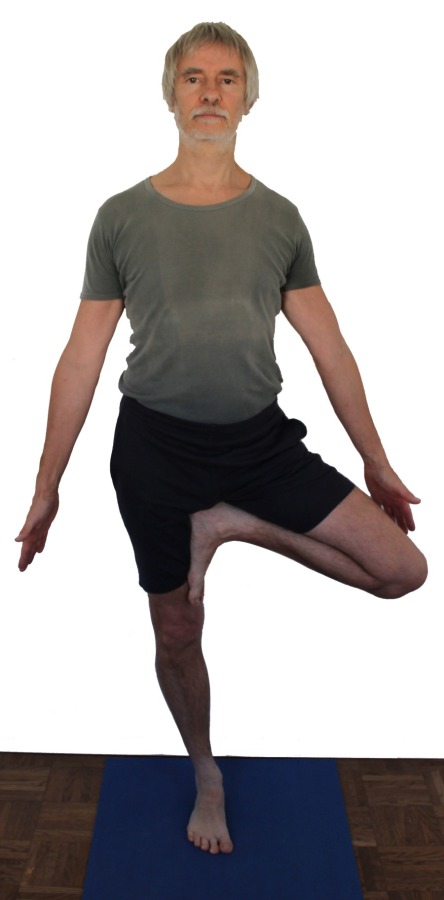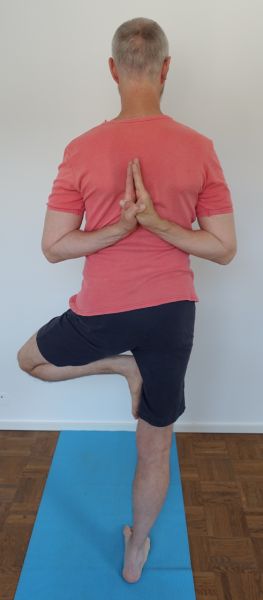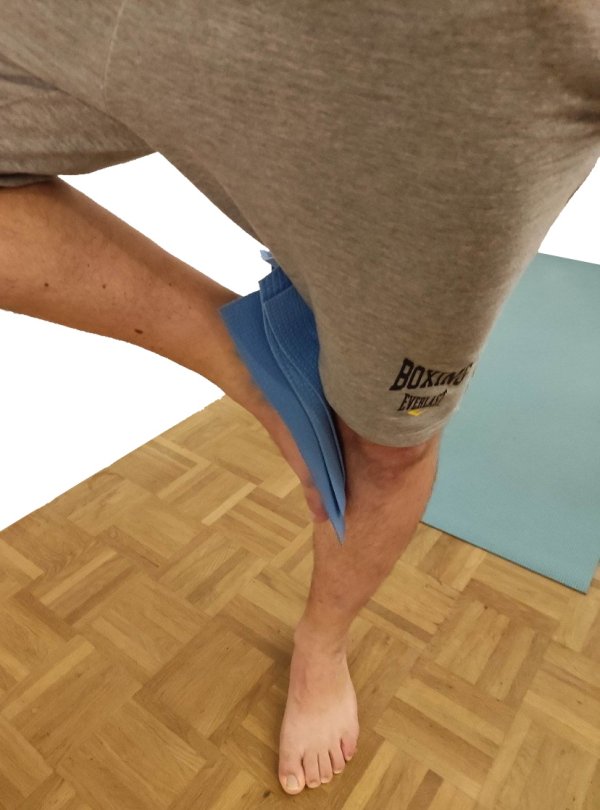Contents
vrksasana
„tree“

 instructions and details with working links as PDF for download/print
instructions and details with working links as PDF for download/print
Feedback: We’d love to hear what you think about this description, give us feedback at:
postmeister@yogabook.org
last update: 12/30/2018
Name: vrksasana
Trivial name: Tree
Level: FA
- Classification: FA
- Contraindication
- Effects of
- Preparation
- follow-up
- derived asanas
- similar asanas
- diagnostics
- Instruction
- details
- Variants
Classification
classic: standing posture
psychomental: balanced posture, concentrated and introverted
physiological: slight lateral hip opening
Contraindication
Effects
- (842) Strengthening the foot lifts
- (872) Strengthening the pronators of the ankle joint
- (862) Strengthening the supinators of the ankle
Preparation
As is so often the case, shortened hip flexors (especially the iliopsoas) tilt the pelvis into a hollow back:
- hip opener 1
- hip opener 2
- warrior 1 pose
- upface dog
- urdhva dhanurasana (back arch)
- ustrasana (camel)
- setu bandha sarvangasana
and several other backbends with hip extension. A very important movement in this pose is the exorotation in the hip joint. Preparations for this:
- baddha konasana
- supta baddha kon asana with a very similar leg position
- Half lotus forward bend
- hip opener at the edge of the mat
- hip opener 3
- warrior 2 pose with very similar leg position
- caturkonasana with very similar leg position
- parsvakonasana
- counter
Very good flexibility of the monoarticular quadriceps parts is required so that the foot does not slip down from the inner thigh but can be placed as high as possible on the leg and remain there. Practice this:
- virasana
- supta virasana is less effective than virasana in this respect
- Quadriceps stretch 1 on the wall
- Quadriceps stretch 2 on the wall less effective than virasana in this respect
- malasana
- maricyasana 1
- maricyasana 3
- krouncasana
- supta krouncasana
- ardha supta krouncasana
Balancing on one foot is one of the easiest of all the balancing poses, so that hardly any other pose can be described as a preliminary exercise in this respect. Synergistic, however:
- warrior 3 pose
- hasta padangusthasana, sideways and forwards
- eka pada prasarita (one leg raised) variant of uttanasana
- ardha chandrasana
- parivrtta ardha chandrasana
- Back stretch with one leg raised
Follow-up
derived asanas:
similar asanas:
Diagnostics (No.)
In vrksasana, a hollow back tilt based on a shortening of the hip flexors can be easily recognized due to the stretched standing leg and the upwardly stretched trunk, if despite intensive work of the extensors in the hip joint (i.e. not only the hamstrings but also the gluteus maximus) no upright pelvis can be produced.
(293) Excessive tension in the trapezius ( urdhva hastasana variation):
The trapezius, which is significantly involved in lifting and rotating the shoulder blades, is probably one of the most tense muscles in Western civilization. Internal and external posture, including today’s widespread VDU workstations, contribute significantly to this. If the trapezius in the „urdhva hastasana“ variant of vrksasana shows a tendency to spasm after a short time, it must be assumed that the tension is excessive.
(880) Overextending the knee joint in the standing leg
Overextension of the knee joint refers to the ability to or the current state of an angle of more than 180° in the knee joint. To a certain extent, this is considered normal by anatomists and is on average more common and more pronounced in females. However, it can also indicate a weakness of the quadriceps. Furthermore, hyperextension often causes unphysiological sensations that are not caused by stretching or exertion of the muscles and should be avoided, see also FAQ. Shortened hip flexors, which pull the thigh forward when the pelvis is straightened, can conceal the ability to hyperextend.
(231)(234) Shoulder ( urdhva hastasana variation):
In urdhva hast asana, the flexibility of the shoulder can be recognized, including side discrepancies, and there may be indications of diseases of the shoulder:
- irritable hypertonus of the deltoid: ambitious beginners in yoga in particular tend to develop irritation in the deltoid, which is localized in the area of the muscle origins, probably stems from an overstrain of the structures due to frequent repeated demands in full frontal abduction and is also noticeable in just such a strain, see the FAQ.
- Various pathological changes in the shoulder joint such as impingement syndrome, frozen shoulder, calcification of the biceps tendon, which cannot all be discussed here and require clarification.
- side discrepancies in flexibility
The flexibility of the shoulder can be recognized by the degree of deviation in the three dimensions of movement:
- Outward deviation of the upper arms with or without flexion of the elbow joints.
- Loss of rotation of the arms
- Incorrect angle of frontal abduction that does not reach 180° or not permanently.
(650) Kyphosis and lordosis of the spine:
The deviations from the physiological double-S shape of the human spine become quite visible in this posture. There should be a certain degree of lordosis (convex spine from the front) in the lumbar and cervical spine and a certain degree of kyphosis (convex spine from the back) in the thoracic spine. See the FAQ. In this pose, shortened hip flexors can cause hyperlordosis, which can already be eliminated by slightly bending the knee joint.
The main reason for the inability to press the heel against the perineum at least briefly when assuming the posture and for the leg slipping off the thigh in the posture is the extension moment in the knee joint, which results from the tension of the (especially monoarticular) quadriceps parts. It can regularly be seen that if the ischial tuberosities do not press firmly on the floor in virasana, there is a risk that the foot will slip in vrksasana. Conversely, it can be estimated that if the buttocks reach the wall in the quadriceps stretch on the wall, this problem no longer exists. By design, virasana and quadriceps stretch 1 on the wall are also the most important preparatory exercises for this aspect of the pose.
(852) Calves:
In this pose, the calf muscles are clearly stressed; the further the load moves from the heel towards the balls of the feet, the greater the strength endurance demand on the calf muscles (the triceps surae). However, the calf is less prone to cramps in this position. If calf cramps occur quickly, this often indicates a lack of strength endurance or a supply problem such as a lack of calcium (possibly also at rest) or magnesium (load-dependent) in the blood or a lack of blood circulation. As a rule, this has nothing to do with calf cramps occurring at night, which are typically caused by sustained stretching movements(plantar flexion) in the ankle due to the current dream event. However, if cramps occur at rest, this may indicate a calcium deficiency.
(950) Foot deformities:
As a one-sided posture, deformities of the foot are even easier to observe here than in symmetrical postures, especially fallen arches and flat feet, but also others. Whereas in uttanasana, tadasana, urdhva hastasana and other standing postures they tend to appear less pronounced because the feet are pushed away from each other by the force of the abductors, this possibility is eliminated here and the full picture becomes visible, especially as this posture allows the best view of the inner foot. Furthermore, the body load carried by only one leg may reveal damage to the leg apparatus that does not become apparent in situations on both legs or under purely dynamic load distribution between the legs, such as when walking.
(960) Foot:
In this pose, misalignments(subluxations) of foot bones, usually tarsal bones or the metatarsal bones, can become noticeable directly or in the adjacent joints. In addition, in the case of hallux valgus, the metatarsophalangeal joint area of the big toe will show increased pressure pain. Metatarsalgia is pain due to pressure or movement in the area of the ball of the foot and can have various causes.
Variants:
instruction
- Stand in tadasana and shift your weight onto your left leg.
- Slowly lift the right leg off the floor without jeopardizing the safety of the stance or compromising the upright, straight position.
- Grasp the right foot with the right hand.
- Place the right foot as high as possible on the left inner thigh.
- Press the foot moderately hard against the thigh.
- Move the right knee backwards as far as possible without rotating the pelvis; turn the right leg out as far as possible.
- Straighten the pelvis to the maximum; the pomus muscles or the hamstrings work continuously to achieve this.
- Push the foot back against the resistance of the thigh without changing the other parameters.
- Take the arms in namaste.
Details
- Make sure that you remain straight in the pelvis
- with regard to the rotation to the side. If the flexibility of the adductors is rather limited, there is often a tendency to turn the pelvis from the prescribed position in the direction of the lifted leg, as this exhausts the range of motion unexpectedly early.
- With regard to tilting forwards, use the pomus muscles and the hamstrings for this. Mobility-restricted hip flexors and adductors tend to tilt the pelvis forwards and downwards, the more restricted, the more.
- With regard to lateral tilting: overexertion or hypertonus of the gluteus medius and gluteus minimus cause the pelvis to tilt unsustainably to the side of the standing leg, i.e. the raised leg lifts. This can be further enhanced by the precise geometry with which the lifted leg is positioned. If there is a lack of flexibility in the monoarticular parts of the quadriceps, i.e. if the heel is approximately at knee level, the lower leg pushes the pelvis upwards on its side via the knee and thigh. If the small glutes are weak, the pelvis on the side of the lifted leg can sink downwards unsustainably if the bent leg does not push the pelvis upwards as described above.
- Keep the pelvis level and extend both sides of the trunk upwards.
- Maintain continuous work of the quadriceps to extend the knee joint. Do not bend the standing leg at any time.
- Maintain continuous work of the extensors of the hip joint (especially the gluteus maximus and hamstrings) to straighten the pelvis. If this results in increased flexion ofthe knee joint, this is due to shortened hip flexors and requires increased strength in both the quadriceps and the gluteus maximus as well as regular stretching of the hip flexors. With flexible hip flexors, the hamstrings is usually sufficient; for more powerful actions (and from greater flexion angles), the gluteus maximus is usually also active. In all cases, however, the tensing of the medial hamstrings should be felt on the inner heel of the placed foot when attempting to straighten the pelvis, which immediately stops again when the muscular work to straighten the pelvis is interrupted.
- The tendency of the foot placed on the inner thigh to slide downwards is often attributed to the lack of friction of the clothing. However, this is only one – and the lesser – part of the cause. The most important reason lies in the extensor moment that prevails in the knee joint, i.e. ultimately the tension in the quadriceps. The more mobile these become, the lower the extension moment they generate, the less they extend the knee joint in the stance. The foot is placed as high as possible on the inner thigh, if possible with the heel directly on the perineum. The thigh and lower leg then sink towards the floor in line with gravityso that, unless the foot also slips, the knee of the bent leg is lower than the foot and the weight of the leg presses the foot more against the thigh and increases friction. This effect must outweigh the extension moment in the knee joint so that the foot does not slip. The virasana and the quadriceps stretch on the wall are therefore suitable as a preliminary exercise. Of course, as long as necessary, the lower leg can be held by the malleoli with the hand on the same side or, as in the variation below, a belt can be used.
- The rule is: the standing leg NEVER bends.
However, if the flexibility in the hip joint in the direction of flexion and also the flexibility of the hip flexors is very limited, this may be necessary. It may be necessary to flex the hip joint of the standing leg slightly and also flex the upper body (bend forward) in order to reach the foot with the hand. The flexed raised leg is no longer limited in its lift by the hamstrings, but only by the short hip extensors. Therefore, pulling the leg upwards can lead to a slight reduction in flexion in the hip joint of the standing leg or even to its short-term extension, which may result in an uncontrollable flexion tendency in the knee joint of the standing leg.
Variants
urdhva hastasana

Instruction
- Take the pose as described above, but stretch your arms upwards as in urdhva hastasana.
Details
- The altered mass distribution makes the balance a little more difficult.
- If the arms are moved forcefully backwards, there is also a tendency to tilt the upper body backwards, which, together with the tendency not to straighten the pelvis properly due to any shortening of the hip flexors, can increase the overall hollow of the back and also the hollow back. Added to this are the two mechanisms described in urdhva hastasana: the pull of the lastissimus dorsi on the posterior iliac crest and the widespread principle of associated movement.
Arms as in 1st warrior pose

Instructions
- Take the pose as described above, but hold the arms as in the 1st warrior pose, i.e. overhead, moving backwards and upwards, shoulder blades elevated, palms facing each other.
Details
- This arm position is much less prone to trapezius spasms.
caturkonasana arm pose

Instructions
Take the pose as described above, but hold the arms as in caturkonasana.
Details
This arm position is much less prone to trapezius spasms.
with namaste

instructions
- take the pose exactly as described above.
Details
- The above description of the basic pose is the variant with namaste.
with namaste on the back
Instruction
- Take the pose as described above, but keep your hands on your back as in the namaste.
Details
- This arm position is much less prone to trapezius spasms.
With belt

Instructions
- Place a belt around the right ankle before starting the pose.
- Take the pose as described above. If the right knee joint cannot bend sufficiently, place the foot on the left inner thigh so that it no longer slips. Hold the foot up by the belt with the pull of the right hand.
Details
- A good ability to stretch the quadriceps (here more the three monoarticular parts) is crucial for the ability to place the foot high enough to prevent it from slipping. If this is not the case, the extensor moment in the knee joint is still too great for the friction on the inner thigh to prevent the foot from slipping downwards. The belt then helps to hold the foot in position, but care must be taken to ensure that the foot is pulled forward as little as possible with the belt; the direction in which it should move on the inner thigh is backwards!
- Holding the belt with the hand should not cause the shoulder blade to lose its retroversion and depression.
with patches

Anleitung
- Take the position as described above, but place a patch between the foot and the inner thigh.
Details
- The patch provides significantly better friction, so that a greater residual stretching moment from mobility restrictions of the quadriceps can be absorbed.
Transition to warrior 3 pose
Instruction
- Take the pose as described above in the variations with arms overhead as in urdhva hastasana.
- Release the placed foot from the inner thigh and stretch the leg parallel to the standing leg towards the floor without resting it on the floor.
- Tilt the hip joint of the standing leg into flexion until the 3rd warrior pose is reached.
Details
- Since the free leg to be lifted must be released from the floor anyway in order to assume the 3rd warrior stance, it is not even placed on the floor for the transition.
- In principle, the 3rd warrior pose can of course also be taken from other variations of vrksasana with regard to the arm position, but it is then advisable to bring the arms into the urdhva hastasana position before the transition.
